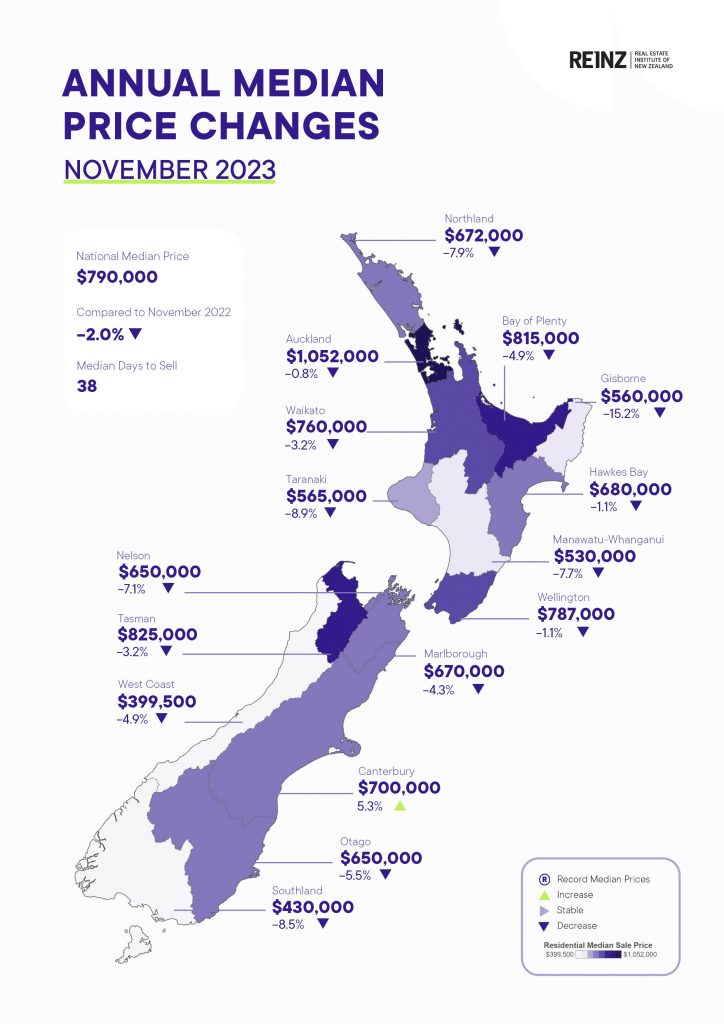November has brought the expected lift in the number of properties coming to market and a significant increase in the number sold – a sign of positivity returning to the market, REINZ Chief Executive Jen Baird says

November continues the trend of slow and steady improvement in property market activity now that the country is past the election, and we head into more active months in the property cycle.
The Real Estate Institute of New Zealand’s (REINZ) November 2023 figures show more sales activity, more listings coming to market, lower days to sell and a sense of more confidence overall (year-on-year).
We’ve seen steady activity again this month with a solid increase in the number of properties sold, up by 15.7% (from 5,550 to 6,422) month-on-month, and up by 12.2% (from 5,724 to 6,422) compared to November 2022. For New Zealand excluding Auckland, the total number of properties sold has followed a similar pattern, increasing by 17.0% month-on-month and increasing by 12.2% year-on-year.
Across the regions, the data shows that only three of the sixteen regions had a decrease in the number of properties sold month-on-month, (West Coast -5.6%, Taranaki -2.1% and Otago -0.3%) and only two had decreases year-on-year (Nelson -16.9% and West Coast -2.9%). Comparatively, Nelson was also the region with the biggest increase month-on-month for November, with a 51.3% increase, followed by Tasman at 32.8% and Wellington at 31.1%.
The national median sale price remained largely unchanged compared to last month, increasing by $1,000 to $790,000. Year-on-year, there is a slight national decrease of 2.0% from $806,000, while New Zealand excluding Auckland is down by 1.4% to $700,000 from $710,000.
Median sale prices are still mixed this month with half of the regions having between 0% and 3.1% increase month-on-month. The remaining regions had a decrease in the median sale price, albeit at less than 4%. West Coast stood out from the other regions with a 17.4% increase month-on-month to $399,500 from $340,000.

Local agents are reporting steady activity across different buyer groups, with more competition for buyers’ attention in areas where listings have increased. With median prices either largely unchanged or slightly lower year-on-year in a number of regions, for some buyers, now will be the time to act.
November has brought the expected lift in the number of properties coming to market and a significant increase in the number sold – a sign of positivity returning to the market. Open home attendance numbers and auction room activity have picked up as well in many parts of the country and we expect to see the number of properties sold across New Zealand increase in December, as we enter the busier season for real estate and people taking action to sell or buy before the pause at Christmas. Overall sentiment appears to be more positive, although this does vary by region.
The market is continuing to move a little quicker. The national median Days to Sell has remained the same this month at 38 days compared to last month, and decreased year-on-year by three days for New Zealand from 41. Regionally, West Coast again saw a decrease of 22 days, with Nelson close behind with a 17-day decrease in median Days to Sell month-on-month.
At the end of November, the total number of properties available for sale across New Zealand was 28,014, down 1.5% (435 properties) from 28,449 year-on-year, and up 9.4% month-on-month. For New Zealand excluding Auckland, inventory increased marginally by 113 properties (0.6%) year-on-year from 17,579 to 17,692 and increased 9.8% month-on-month.
Nationally, new listings increased by 5.2% from 10,185 to 10,712 listings year-on-year and increased 12.4% month-on-month. New Zealand excluding Auckland also saw an increase month-on-month of 12.9% and year-on-year of 2.5%.
We’ve seen a large jump in the number of listings coming to market this month compared to last month. Notably, Gisborne with a 75% increase and Manawatu-Whanganui, Wellington, and Nelson all reached increases in the mid-20% range. Year-on-year numbers remained mixed but we are watching more signs in the rolling months of an improving market.
While factors like interest rates continue to impact the market, it certainly looks as though buyers and sellers are heartened by the fact that the election is over and the Official Cash Rate is stable. Although we will see some slowing over the Christmas period, we anticipate seeing a resurgence of activity from the end of January, as the boost in market positivity helps raise confidence further.
The HPI for New Zealand stood at 3,686 in November 2023, showing a 0.8% increase compared to the previous month. However, when compared to the same period last year, the HPI reflects a 0.2% decline. The average annual growth in the New Zealand HPI over the past five years has been 6.1% per annum. It remains 13.8% below the peak of the market in 2021.






